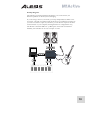
9
About the Hi-Boost Switch
This switch engages a 2dB shelving filter starting at 3 kHz that will boost when set
to “+”, cut when set to “-”, and will be bypassed when set to “0.”
If your mixing environment has many acoustically reflective surfaces and sounds
overly “bright,” you can compensate for this by reducing the high frequency
output of the M1Active 520/620. Conversely, if you are mixing in an acoustically
“dead” room with lots of sound absorption and little reflection, you can boost the
high frequency output.
If you’re not sure about your control room, leave this setting to “0,” mix a few
songs, and play those songs in different environments (i.e., your living room, car,
boombox, etc.) Your mixes should fall into one of the following three categories:
1.) Too bright: If your mixes have too much high frequency content and
consistently sound too bright, then set Hi-Boost to “+” because your control
room is acoustically “dead.”
2.) Too dull: If your mixes consistently lack high frequency “sparkle” and sound
“dull” it means your control room is too acoustically reflective and that you
should set your Hi Boost switch to “-.”
3.) Just right! If your mixes translate well, then leave this switch set to “0” since
your control room is well balanced and you don’t need any high frequency
compensation from the speaker.


















